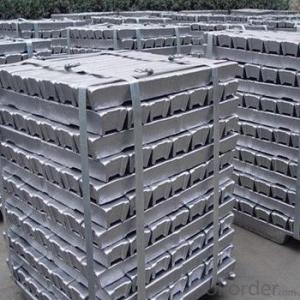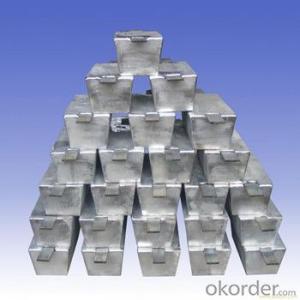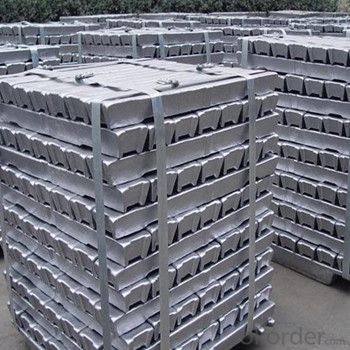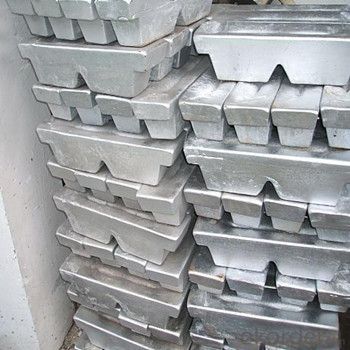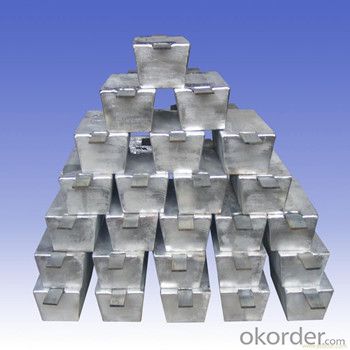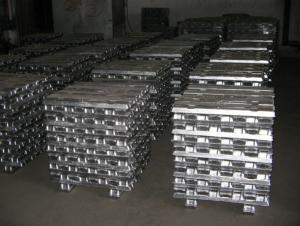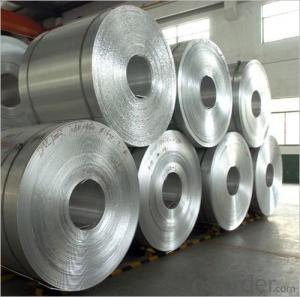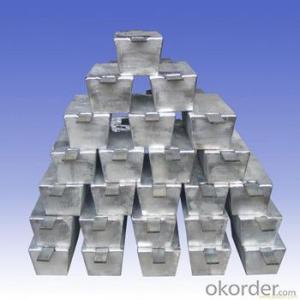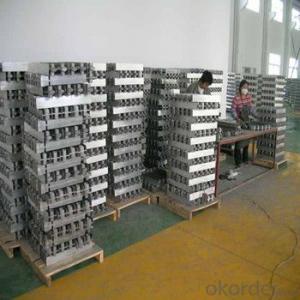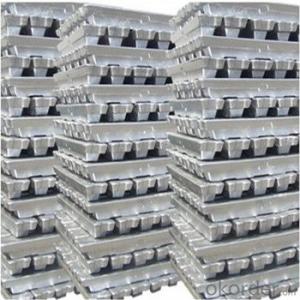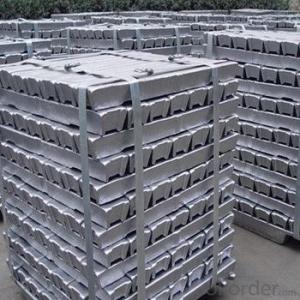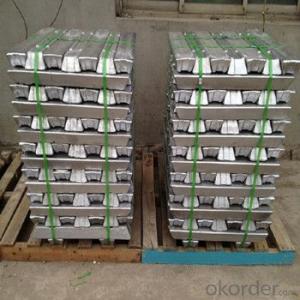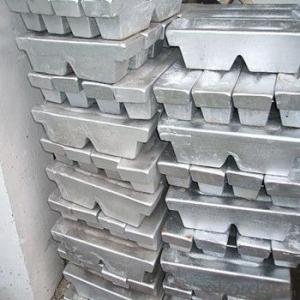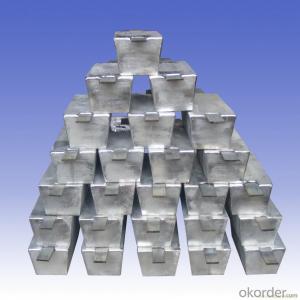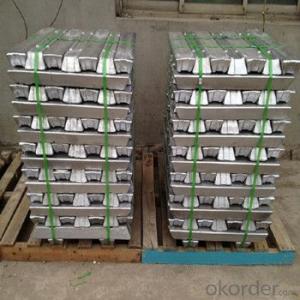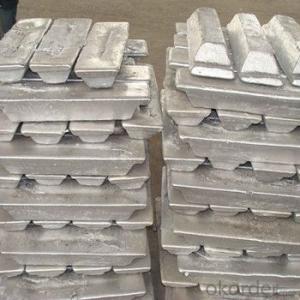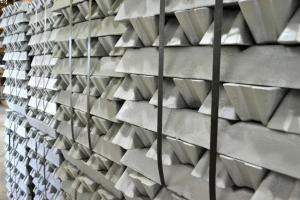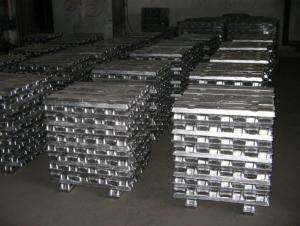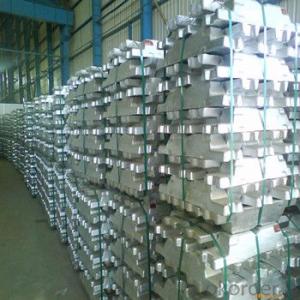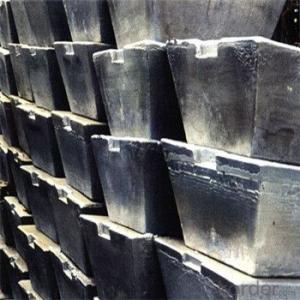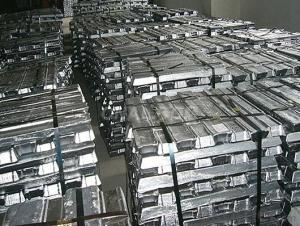Aluminium Ingot 99.97% for Choice with Top Quality
- Loading Port:
- China main port
- Payment Terms:
- TT OR LC
- Min Order Qty:
- 1000 m.t.
- Supply Capability:
- 10000 m.t./month
OKorder Service Pledge
OKorder Financial Service
You Might Also Like
Pure Aluminum Ingot Used for Industry
1.Structure of Aluminum Ingot Description
Aluminum Ingot is with the AL as the main chemical composition. Aluminum Ingot is used for industry,such as automobile,pinning and weaving,electron broadly and so on. Aluminum Ingot has the following advantages: easy control and operation, fast melting.
2.Main Features of the Aluminum Ingot
•High Purity
•Easy control and operation
•High strength
•Fast melting
•Competitive price
•Best Service
3. Aluminum Ingot Images
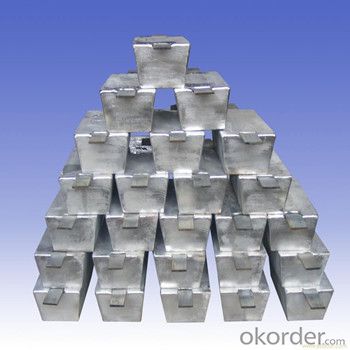
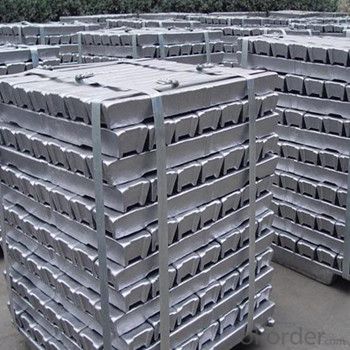
4. Aluminum Ingot Specification
Grade | Chemical Composition % | |||||||||
Al≥ | impurities ≤ | |||||||||
Si | Fe | Cu | Ga | Mg | Zn | Mn | others | Sum | ||
Al99.9 | 99.90 | 0.50 | 0.07 | 0.005 | 0.02 | 0.01 | 0.025 | - | 0.010 | 0.10 |
Al99.85 | 99.85 | 0.80 | 0.12 | 0.005 | 0.03 | 0.02 | 0.030 | - | 0.015 | 0.15 |
Al99.7 | 99.70 | 0.10 | 0.20 | 0.010 | 0.03 | 0.02 | 0.030 | - | 0.030 | 0.30 |
Al99.6 | 99.60 | 0.16 | 0.25 | 0.010 | 0.03 | 0.03 | 0.030 | - | 0.030 | 0.40 |
Al99.5 | 99.50 | 0.22 | 0.30 | 0.020 | 0.03 | 0.05 | 0.050 | - | 0.030 | 0.50 |
Al99.00 | 99.00 | 0.42 | 0.50 | 0.020 | 0.03 | 0.05 | 0.050 | - | 0.050 | 1.00 |
5.FAQ of Aluminum Ingot
We have organized several common questions for our clients,may help you sincerely:
①How about your company?
A world class manufacturer & supplier of castings forging in carbon steel and alloy steel,is one of the large-scale professional investment casting production bases in China,consisting of both casting foundry forging and machining factory. Annually more than 8000 tons Precision casting and forging parts are exported to markets in Europe,America and Japan. OEM casting and forging service available according to customer’s requirements.
②How to guarantee the quality of the products?
We have established the international advanced quality management system,every link from raw material to final product we have strict quality test;We resolutely put an end to unqualified products flowing into the market. At the same time, we will provide necessary follow-up service assurance.
③How long can we receive the product after purchase?
In the purchase of product within three working days, We will arrange the factory delivery as soon as possible. The pecific time of receiving is related to the state and position of customers.Commonly 7 to 10 working days can be served.
- Q: How are aluminum ingots used in the production of modular buildings?
- Due to their unique characteristics and properties, aluminum ingots play a vital role in the production of modular buildings. These ingots are melted and then converted into different components, including beams, columns, panels, and other structural elements, which are used to construct the modular units. One advantage of aluminum is its lightweight nature, making it an ideal choice for modular construction. Aluminum ingots are significantly lighter than steel but still offer excellent strength-to-weight ratio, ensuring the durability and stability of the modular building. Furthermore, this lightweight characteristic allows for easier transportation and assembly of the modules, resulting in reduced construction time and costs. Additionally, aluminum provides exceptional corrosion resistance, which is particularly advantageous for modular buildings that may be exposed to harsh weather conditions or coastal environments. This resistance to corrosion guarantees that the building will maintain its structural integrity and appearance for a longer period, reducing the need for maintenance and repair. Moreover, aluminum ingots are highly versatile and can be easily molded and shaped into various forms and sizes. This flexibility enables architects and designers to create innovative and customized modular building designs that meet different functional and aesthetic requirements. Furthermore, aluminum can be easily recycled, making it a sustainable choice for modular construction projects that align with the growing demand for environmentally friendly and energy-efficient buildings. To summarize, aluminum ingots are used in the production of modular buildings due to their lightweight, corrosion-resistant, versatile, and sustainable properties. These ingots are transformed into various components that provide strength, durability, and flexibility to the modular units, facilitating faster construction, reducing costs, and ensuring long-term performance.
- Q: How are aluminum ingots inspected for quality?
- Aluminum ingots are inspected for quality through a thorough and systematic process. The inspection typically involves visual examination, dimensional measurements, and various testing methods. Firstly, visual inspection is conducted to identify any surface defects, such as cracks, dents, or impurities. This is performed by trained inspectors who closely examine the ingots to ensure they meet the required standards. Next, dimensional measurements are taken to verify the ingots' size and weight. This involves using precise instruments like calipers or digital measuring devices to check the length, width, height, and weight of each ingot. These measurements are compared against the specified tolerances to ensure compliance. In addition to visual inspection and dimensional measurements, various testing methods are employed to assess the mechanical properties and chemical composition of the aluminum ingots. These tests can include hardness testing, tensile strength testing, impact testing, and spectroscopic analysis. Hardness testing determines the resistance of the ingot to indentation or deformation, providing insights into its strength. Tensile strength testing measures the maximum amount of stress the ingot can withstand before breaking. Impact testing assesses the ingot's ability to absorb energy under sudden loading conditions. These tests help identify any weaknesses or inconsistencies in the ingot's mechanical properties. Furthermore, spectroscopic analysis is used to determine the chemical composition of the ingots. This involves analyzing the elements present in the aluminum alloy and comparing them against the specified composition. It ensures that the desired alloying elements are present in the correct proportions, ensuring the ingots' suitability for specific applications. Overall, the inspection of aluminum ingots for quality involves a combination of visual examination, dimensional measurements, and various testing methods. By following these rigorous quality control procedures, manufacturers can ensure that the aluminum ingots delivered to customers meet the required standards and are of high quality.
- Q: How is the price of aluminum ingots determined?
- The price of aluminum ingots is determined by various factors, including supply and demand dynamics, production costs, market conditions, and global economic trends. Additionally, factors like trade tariffs, currency fluctuations, and government policies can also influence the price. As aluminum is a globally traded commodity, its price is determined through market mechanisms, such as futures contracts and metal exchanges, where buyers and sellers negotiate and determine the value based on these factors.
- Q: How much does it cost to process the aluminum ingots into T5-6063 models? Now, what about costing the aluminum ingot or the aluminum bar?
- 6063 is the alloy brand, T5 by the high temperature forming process cooling, and then the artificial aging stateThe utility model is suitable for artificial aging products after being cooled by the high temperature forming process without being cold processed (which can be straightened and straightened without affecting the mechanical performance limit)
- Q: How can the aluminum factory calculate the cost better?
- Cost of aluminum material = raw material price (futures aluminium ingot price) company's processing fee.
- Q: What are the advantages of using aluminum ingots in the production of aircraft structures?
- There are several advantages of using aluminum ingots in the production of aircraft structures. Firstly, aluminum is known for its lightweight properties. This is crucial in the aerospace industry as it helps reduce the overall weight of the aircraft, leading to improved fuel efficiency and lower operating costs. The use of aluminum ingots allows manufacturers to create lightweight yet strong structures, enabling aircraft to carry more payload or fly longer distances. Secondly, aluminum has excellent corrosion resistance. Aircraft are exposed to various environmental factors such as moisture, humidity, and temperature fluctuations. Aluminum's natural corrosion resistance helps protect the aircraft's structure from degradation over time, ensuring durability and longevity. Additionally, aluminum ingots offer high strength-to-weight ratio. This means that even though aluminum is lighter than most metals, it still possesses remarkable strength. This property is crucial in aircraft structures, as it allows engineers to design components that can withstand the stresses and forces experienced during flight, ensuring the safety of passengers and crew. Moreover, aluminum is highly malleable and can be easily formed into complex shapes. This flexibility in manufacturing allows for intricate designs and precise engineering, enabling the production of aerodynamically efficient and structurally sound aircraft structures. It also simplifies the assembly process, reducing production time and costs. Furthermore, aluminum is a widely available and cost-effective material. Its abundance makes it easily accessible for manufacturers, ensuring a steady supply chain. Additionally, its cost-effectiveness allows for more affordable aircraft production, making air travel more accessible to a larger population. In conclusion, the advantages of using aluminum ingots in aircraft structures include lightweight properties, corrosion resistance, high strength-to-weight ratio, malleability, and cost-effectiveness. These characteristics make aluminum an ideal choice for aerospace manufacturers, contributing to the overall efficiency, safety, and affordability of aircraft production and operation.
- Q: What type of spectrometer is used to analyze aluminium ingots?
- If it is an ordinary aluminum ingot, two or three 9, with direct reading spectrometer can be done. It is better to choose the imported equipment with stability and repeatability.
- Q: What can aluminium ingots do?
- In our daily industrial raw materials called aluminum ingot, according to the national standard (GB/T 1196-2008) should be called "remelting with aluminum ingot", but we are used to "aluminum ingot"".
- Q: How much is the power consumption to smelt a ton of aluminium ingot?
- Plus you want to formula to aluminum alloy brand, higher temperature, and insulation process, estimated 700-800 degrees of electricity; processing into aluminum plate must be 1000 degrees electricity.
- Q: What is the average price of an aluminum ingot?
- The price of an aluminum ingot can fluctuate based on several factors, including market conditions, supply and demand dynamics, and regional influences. As of [current date], the average price stands at around [average price]. Nevertheless, it is crucial to acknowledge that this value is prone to alterations. It is advisable to seek guidance from industry sources or market experts for the latest and most accurate pricing information.
Send your message to us
Aluminium Ingot 99.97% for Choice with Top Quality
- Loading Port:
- China main port
- Payment Terms:
- TT OR LC
- Min Order Qty:
- 1000 m.t.
- Supply Capability:
- 10000 m.t./month
OKorder Service Pledge
OKorder Financial Service
Similar products
Hot products
Hot Searches
